- Code : #0949 S 10 mg
- Formula : C₂₆H₂₉O₁₅Cl
- CAS : 33012-73-6
Aristotelia chilensis
Aristotelia chilensis, generally known as “Maqui” (or “Chilean wineberry” in English ), belongs to the Elaeocarpaceae botanical family. It is either a shrub or a tree that can be 5 m tall. Native to South America (andean regions of Chile and Argentina), it grows in humid slopes, hills and margin forests and easily colonizes land that has lost its vegetation cover.
Maqui berries are eated raw or dried and used to make “wineberry”. Their pigment is used as a purple dye in food, cosmetics and pharmaceuticals.
Native Mapuche communities in Chile have traditionally used it to cure chronic diarrhea, dysentery, throat diseases, intestinal tumors, fever, wound healing and scars. Fruits and leaves have been investigated for antioxidant, antidiabetic and antiviral activities.
Among the fruit’s main constituents are anthocyanins: delphinidin-3,5-diglucoside being the most abundant, myricetin and rutin, quercetin, kaempferol, cathechin, epicatechin, gallocatechin gallate, cinnamic and benzoic acid derivatives.

- Code : #0916 5 mg
- Formula : C₃₂H₃₉O₂₀Cl
- CAS : 53925-33-0
- Code : #0932 S 20 mg
- Formula : C₂₇H₃₁O₁₆Cl
- CAS : 2611-67-8
- Code : #0941 S 10 mg
- Formula : C₂₇H₃₁O₁₇Cl
- CAS : 17670-06-3
- Code : #0948 5 mg
- Formula : C₂₆H₂₉O₁₆Cl
- CAS : 53158-73-9
- Code : #0917 5 mg
- Formula : C₃₂H₃₉O₂₁Cl
- CAS : 36415-91-5







